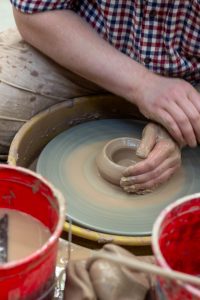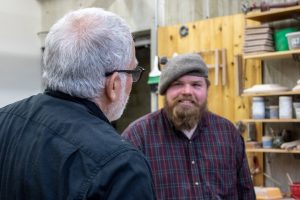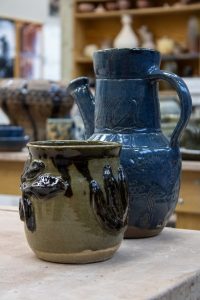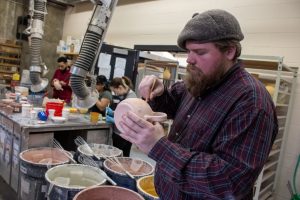 Softly, over the din of the clay mixer and the shuffling of utensils that echo across the Art Department, Robert Banker explains, “Think deeply about what it is you’re making and why. And what do you have to say? All of you have something to say.”
Softly, over the din of the clay mixer and the shuffling of utensils that echo across the Art Department, Robert Banker explains, “Think deeply about what it is you’re making and why. And what do you have to say? All of you have something to say.”
These are his first true words of encouragement for the students of Ceramics II in Spring Semester of 2024.
I think back over the last 10 weeks of Fall Semester, 2023, and one thought rings true across my perception: on the clay wheel, my hands touch a craft my ancestors worked in long ago. Deep within the chasm of my inner being, I can feel an ancestral connection to taking a lump of dirt and imbuing it with a portion of my soul, transforming earth from chaotic deposition of sediment into a human form that our species can understand.
I think about Robert’s first words to me about clay, “I think you’ll be better than you give yourself credit for.”
Those words hit me far differently than his first words about his class. It was a Tuesday morning, I was exhausted from poor sleep, I hadn’t had coffee, and there was a gray-haired, boomer instructor standing before us waffling on about how, “if you are only in here to get an easy A, you need to talk to your advisor about dropping this class and enrolling in Art Appreciation.”
In his class, he explained, “you will work hard and need to be here outside of class times if you want to learn and create.”
 These assurances, from a gentleman who looked like he had worked here since my aunts attended RCTC in the 90s, were off-putting. Two months later and 100 hours of free time spent playing in the mud making cups and pots, though, and I was explaining to my tutor from the Writing Center that, “one of my ancestors must have been a potter because I can feel their echoes in my hands when I throw.”
These assurances, from a gentleman who looked like he had worked here since my aunts attended RCTC in the 90s, were off-putting. Two months later and 100 hours of free time spent playing in the mud making cups and pots, though, and I was explaining to my tutor from the Writing Center that, “one of my ancestors must have been a potter because I can feel their echoes in my hands when I throw.”
As an Army vet and an older student, I thought ceramics was going to be an easy grade that afforded me time to unwind from the previous semesters’ high operational tempo of academia. I had worked incredibly hard to acquire a 4.0 GPAacross two semesters of community college, and that work took a lot out of me. I didn’t want to feel overwhelmed, particularly from something as trivial as an art elective.
My friend Jacob, a fellow veteran, and classmate in Tim O’Neil’s ethics class, advised me to keep at least my history class.
But if I was keeping one class, I was keeping every class.
The choice to stick with pottery and history was a turning point for me as a scholar and an artist. Ceramics and history connect together like music and cinema: it’s common sense to associate our species’ oldest art form with the story of how we got here.
Anywhere you look, across the spectrum of civilization, from the ancient peoples of the Near East from sites like Thebes, to the Steppe of Mongolia and the earliest settlements of North America, broken pottery shards and crumbling clay pots are almost guaranteed to appear someplace. Archeologists have been excavating pieces of pottery and little clay figurines for millenia; the ancient Egyptians even had schools of archeology within their culture who rummaged through crumbling walls made of clay brick and piles of shattered vases.
The pots these archeologists found three thousand years ago were as old to the ancient Egyptians as the pyramids are to us in America in 2024.
Between Robert’s encouragement and patience with his pupils and the primeval connection I feel to building, I started noticing: the days I went home coated in clay were the days I felt happiest.
The dirtier, the better.
It became vital to me to make as many things as I could, as fast as I could, to cultivate the perishableskill of wheel throwing so that I could take home wares and pieces to share with people in my life. All of the experiences I’d had in any class up until that moment in October had been mediocre at best.
After being shown how to fold a slab of clay into a coil, then to form that coil into a bowl, pot, or vase,  something within my soul seemingly awoke. I found myself working late into the afternoon that Thursday. By sundown, I had the start of a beautiful form; my very first lidded pot. The entire pot was constructed using methods of pottery that have existed in human culture since before the manifestation of written language.
something within my soul seemingly awoke. I found myself working late into the afternoon that Thursday. By sundown, I had the start of a beautiful form; my very first lidded pot. The entire pot was constructed using methods of pottery that have existed in human culture since before the manifestation of written language.
Over the course of the next month, I manufactured three uniquely distinct coil pots and a carved stoneware goblet, all based on disparate precedents from across the ancient world. I chose an olla pot based on 16th century Mexican pottery from Spain, an amphora based on ancient Greek amphorae from the Mediterranean, and finished my ancient Akkadian vessel by uniquely shaping the body of the pot with a foot that tapers out at its base.
When Robert asked us to create clay cylinders on the potter’s wheel, I spent three weeks sat at the potter’s wheel for almost 8 hours a day learning how.
On my first attempt, I couldn’t even get the lump to stick to the potter’s wheel. For three days straight, I avoided the potter’s wheel, until I could get the attention of the ceramics adjunct, Crist, who helped me understand the basics of sticking clay to the wheel – lifting clay and centering clay on the wheelhead. By the end of the month of October, I steadily grew more and more confident at centering, opening and throwing clay cylinders. Robert Banker challenged me around the end of the month, by throwing a tall cylinder himself and asking me to shape it into something. I still have that form at home, and it turned out to be one of the more beautiful works I created when still mastering the novice skills of basic pottery.
Late evening in October of fall semester, I had been working at the potter’s wheel, trying my best to throw a cylinder and make what I had come to call a “real” pot. Up to this point, everything I’d made on the potter’s wheel was small, insubstantial and very novice in form. As I spun the wheel head up to speed, centered the lump of clay in front of me and began to make a cylinder, something within me awoke as if called forward from deep within the recesses of my being by the earthen material in my hands. That evening, as I lost myself in my work, I felt like a primeval calling had been awakened within me, and some ancient vestige of my ancestor from a past life called out to the dirt within my hands. Suddenly I was totally absorbed in the shaping and forming of a simple cup, but a marked distinction had been that I had succeeded in making a “real” pot.
 Now, in April, eight months after I elected to stay the course and stick it out with ceramics, I’m an advanced student among my peers on the potter’s wheel, and, crucially, have thrown a few pieces that make me genuinely proud to have found the ancient craft of pottery.
Now, in April, eight months after I elected to stay the course and stick it out with ceramics, I’m an advanced student among my peers on the potter’s wheel, and, crucially, have thrown a few pieces that make me genuinely proud to have found the ancient craft of pottery.
Across the unending spectrum of time’s ebb and flow, somewhere deep within the chasm of my soul, resonating like the timpani of the universe itself, I can sense the voice of a potter, my ancestor, calling out to me through my hands, my fingers and my mind. I can see pots and cups in shapes and forms that don’t require me to draw or sketch.
My grandmother wants me to sell and exhibit, to begin photographing my work to build a portfolio, but all I want to do is feel that echo again and again, drawing my hands and my mind across the clay as it crawls up my fingers and shapes into a beautiful parabolic cylinder.
story by Kyle Pike, photos by Jessica Cormican and Byran Ford
